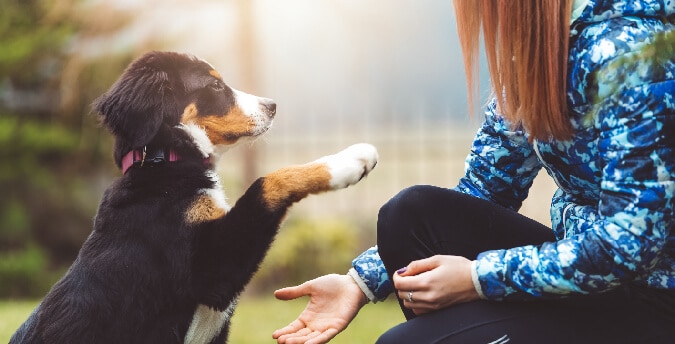My Dog Is Pawing–What Should I Do?

HOW TO STOP A DOG FROM PAWING
Pawing is a natural instinct in dogs that can be used to get to dog food that they want and to get the attention of the one they see as an alpha, or the caregiver of their pack. Pups do it to their mothers, and adult dogs will do it to their humans. Even though it is natural and can be cute when a little puppy is pawing at your leg or hand for attention, it is not always a good thing. There is one major reason to discourage such behavior – it can quickly move beyond being a small nuisance and become a serious problem, especially as your pup grows and gets bigger and stronger. Pawing can cause skin injuries when they catch you with their nails, so always remember to keep your dog’s nails trimmed properly. Also, an over exuberant dog can knock people, especially children, over when they paw at someone while they are standing or while they are trying to stand up or sit down.
Thankfully, pawing behavior can be improved with training, in particular by replacing the scratching with preferable alternatives. Presented here are four things you can do to help curb pawing in your pup:
1. TRAIN AN ALTERNATIVE
Pawing is a natural instinct, but it is also, to some extent, a learned behavior. When a dog paws and gets something in return, they come to associate that reaction with their pawing behavior, so they will keep doing it in order to get what they want – your attention and affection. Try working with your dog, especially if they are still young, on doing something else rather than pawing. You can teach them to sit and shake for attention and can reward them for that good, calm behavior. You can also give them what they are craving- attention- when they do things like nuzzle your hand for attention rather than pawing at you. In time, they will learn that new behavior, and it should replace the negative behavior of pawing.
2. REMOVE ATTENTION FOR PAWING
Another way to train new behavior and get a dog to stop pawing as much is to remove that positive reinforcement. They paw because they want your attention and because you give it to them. Instead, when they paw at you, rather than petting them, withhold that attention. Pull your hand away or gently push them off your leg, and then turn away and remove eye contact. You can even get up and walk away and turn your back on them for 30 seconds or so, then go sit back down. Give attention only when the dog is calm and his paws are grounded. Over time, they will get the idea that pawing doesn’t get them what they want and they will stop doing it. Be aware, however, that when you first start ignoring it, the pawing will get worse as the dog panics and tries to force the positive response out of you. This is where patience and firmness come in and as long as you are strict and don’t give in, they will learn that pawing is not good for getting the attention they want.
3. REGULATE PLAYTIME
Dogs like to play, and they can play rough when they are playing with other dogs. They use their paws to communicate and interact with their “pack,” and they try to do the same with their humans when playing with them. This is where regulated and carefully controlled playtime can be important. Many dogs will end up pawing extra vigorously when they are excited during or right after play time, so people can often get scratched or hurt. You can work on this by giving your dog rubs and pets throughout play time so that they don’t feel deprived and work to keep your dog from getting too wound up. Let them take breaks and rest periods to calm down while they are playing. This can help reduce the severity of pawing when it does occur.
4. INCREASE EXERCISE EACH DAY
In many situations, despite all of the best efforts by their owners, dogs are given too little exercise. All of that pent up energy, and the need to run and be wild and burn off energy, ends up intensifying all of their reactions within the home. This means all actions will be more severe, including destructive ones like chewing and pawing. The ideal amount of exercise for a dog will depend on the breed, size, age, and physical limitations of the dog. It is generally recommend that all dogs have 2 or 3 sessions of exercise each day that has them panting from the exertion (rather than simply from the heat). This will ensure their energy levels are kept low and can really help reduce negative behaviors throughout the day.
